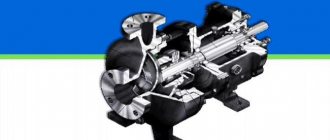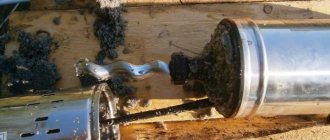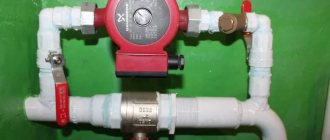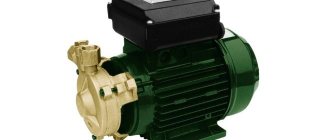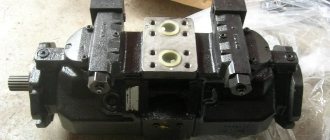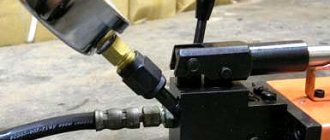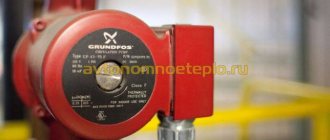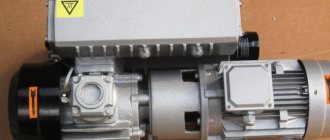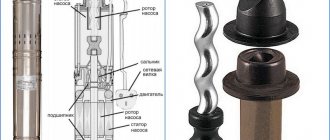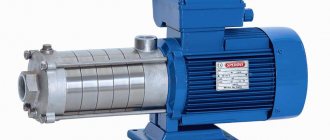The main structural elements of such a pump can be called:
- Piston.
- Stock.
- Sealing materials.
- Valves: inlet and outlet.
- The sealed chamber is represented by a cylinder.
The operating principle of this version of the pumping device is very simple:
- The rod together with the cylinder is at the upper extreme point, due to which the pressure is rarefied and fuel enters the chamber.
- By transmitting force to the rod, the piston moves to bottom dead center, creating pressure that pushes fuel out of the cylinder.
- The valves work in such a way that they do not allow liquid to flow in the opposite direction, and the seals make the chamber more airtight.
There are pumps on sale, grouped into groups: three-plunger, double-plunger, and so on. This method of work is used not only in the manufacture of pumps, but also in other structures.
Unusual application of a car fuel pump
A car fuel pump, given its small size, low power consumption and ease of connection, can be used not only in a car, but also for pumping water in the shower.
To create a compact “automatic” shower, which consists of only four components, you will need to spend about 16 USD on components, of which 9 is on the gas pump itself. You will need: a fuel pump powered by a battery; the battery itself; pipes made of polyvinyl chloride tube with a diameter of 8 mm (“thick” dropper) and a sprinkler.
The fuel pump from the VAZ-2110, however, made in China, was perfect for such a device. This fuel pump model (ESM-2110, part number 2110-1139008) provides stable operation over a supply voltage range of 6 to 15 VDC. This pump is convenient in our case. which has small dimensions and weight (about 0.2 kg) and convenient connection of pipes measuring 8 mm - with their tension on the outlet.
The pump itself (with the supply voltage and a pipe for draining the pumped water connected according to the polarity indicated on the case) is lowered under water, for example, into a bucket of water or other container. Ordinary fresh water has a fairly high resistance to direct current, so the contacts at the point where the electrical conductors are connected to the electric motor are not in danger. There is no threat of malfunction of the electric motor itself: in normal mode it is immersed in the gas tank, and all elements of its electric motor (brushes, stator, rotor, other contacts) are waterproofed.
In addition, the battery voltage is only 12 V, which is quite safe for humans. In order to further reduce the danger or risk of contact with electric current of small voltage and magnitude (for those who are not reassured even by the above explanations), I recommend not immersing the pump entirely in a bucket of water, but connecting such a pipe from polymer dropper with a diameter of 8 mm, leave the pump itself on the ground, and immerse the end of the dropper in a bucket. In this case, the section of the dropper from the pump “water intake” hole should be short in length - 0.5...1 m. And the pipe from the pump outlet can be up to three meters long. This maximum distance was determined experimentally, based on the technical characteristics specified in the “passport” data for the gas pump.
With such sizes of underwater and outlet pipes, in my practice the pump has proven itself reliably when working with a shower sprayer.
To repeat the design you will need:
- fuel pump from a car ( Fig. 1 );
- a pipe made of a polymer dropper with a total length of up to 4 meters;
- connecting electrical wires, for example, two-core electrical wire PVVSh 2×0.75 mm;
- terminals to which the wires are connected;
- battery with a voltage of 12 V and a capacity of 7 Ah;
- shower spray connected through an adapter, on one side of which there is an M8 thread, and on the other - a 1/2 inch thread.
The shower pumping station in action is shown in Fig. 2 and fig. 3 .
Practical use
Such a device will be useful for a “country” (camping) shower right in the open air. By attaching a sprinkler, taken from a regular shower, to a tree or a portable rod stuck into the ground, and standing under it, you can wash yourself with water flowing through the pipe, pumped by an electric pump, from a bucket.
Classification and design of fuel injection pump
Pump sections that provide high fuel pressure for a diesel engine are of three types:
- In-line mechanisms - plunger pairs for each cylinder;
- Distribution, for passenger cars, more compact;
- Main line, used in fuel supply systems.
The latest type of fuel injection pump belongs to a new generation of systems and is controlled by a computer. An injection engine should not be confused with a high-pressure fuel pump, since this is primarily an injection system.
Depending on the type of plunger drive, fuel pumps are pneumatic, hydraulic and mechanical.
Is it possible to pump water using a fuel transfer pump?
To perform pumping of different types of liquid, it is customary to use special equipment. Pumps are divided into two large groups: food, non-food. Another classification feature is viscosity. Today, simple mechanisms have been developed for moving ordinary liquids (water), as well as for thick, viscous substances.
In order for equipment to work with maximum productivity, it is necessary to select it for each type of raw material. If you want to save money but still get high-quality equipment, then contact the professionals. The FTF-SYSTEM company has developed a single pump for diesel fuel, heating oil, and fuel oil. The universal unit can handle substances of any viscosity.
There is no need to experiment and use unsuitable equipment for pumping. Because viscous substances require more powerful technology. Therefore, if you pump water using a fuel pump, you can damage the equipment or, in the worst case, cause an industrial accident.
In most cases, pumps for pumping petroleum products are more powerful than those that move liquid. Their design is durable and reliable.
Pumps for pumping water are hydraulic systems that are used in almost all enterprises. They create fluid flow using drive energy. Most devices are powered by electric motors or internal combustion engines. The scope of application is very diverse: from the energy industry to public utilities and hydraulic transport. Depending on their purpose, pumps come in several types:
- Boreholes - designed for collecting water from narrow wells, the depth of which is about 300 meters.
- Wells - pump liquid into a reservoir and descend to a depth of no more than 8 m.
- Circulating - their main task is to create a water cycle in heating and cooling systems.
- Drainage - with their help you can pump out waste and contaminated water, as well as drain a cellar or basement.
Do you want to purchase a quality pump for industry? Do you want to get a reliable and efficient unit at an affordable price? Then contact FTF-SYSTEM, experienced and qualified managers will select the ideal equipment based on your individual preferences.
Nuances of choice
Before you go shopping for pumping equipment, we recommend that you familiarize yourself with the following recommendations to help you make the right choice:
- If you are faced with the task of transporting fuel over a distance of more than 30 m, then you will need several pumps, which should be placed in a line.
- To create high pressure, we recommend purchasing centrifugal-type pumping equipment.
- It makes sense to purchase axial pumps only if you are going to pump fuel in large volumes and the pressure force is not important to you, which in these installations is at a fairly low level.
- The most popular option among consumers are jet pumps, which are chosen primarily due to the absence of moving elements in their design.
- Vortex pumps are indispensable if you are looking for a lightweight, compact, inexpensive and easy to operate unit.
- Volumetric pumps are ideal for pumping fuel without foreign inclusions. They will allow you to save not only a lot of time, but also energy.
Is it possible to pump water with a fuel pump?
If it works, it will be covered. It is not designed to work in water and will quickly become kaput. 
GASOLINE IS THE LUBRICANT HERE! KAPUT WILL BE IN HIM AND EVERYTHING
If it works, it will be covered. It is not designed to work in water and will quickly become kaput. 
everything is correct about water resistance.. but regarding the lubricating properties of gasoline.. who told you that gasoline and any petroleum products in general have lubricating properties.. for example, we know well that gasoline perfectly removes lubricant from any surfaces.. but try washing your hands gasoline? .. that after this they will be fat. many solvents are also products of petroleum refining... it doesn’t occur to me to lubricate anything with them. so there is gasoline in this pump for cooling.. if it pumps water it will last longer because... The heat capacity of water is greater and the surface tension forces are also greater... i.e. Water will protect you better from wear and tear.
Bullshit. Gasoline lubricates both the injectors and the pump, and in diesel fuel injection pumps. Here
The electrical resistance of water is very high and depends on the applied voltage and the distance between the electrodes. For a voltage of 12 V, the resistance of water can be considered infinitely large - tens of kiloohms. So, the current between the electrodes immersed in water, with a distance between them of 2-3 cm, is 1-3 milliamps. Compared to the motor current, this is an infinitesimal value that can be neglected. I just ask you to take into account that we are talking about water, without the addition of various detergents and acids. You can immerse the motor in clean water (tap, river) without any problems. But for pump mechanics, as moonchild wrote quite correctly, water will be a destructive medium. Firstly, there is rust, and secondly, water does not have lubricating properties.
I saw you messed up the thermostat, I expressed my opinion then, read it. But what if you adapt an old pump for washing injectors? Pour solvent into a jar, pump into the jar. hose from the pump to the ramp, drain from the ramp into a jar? And what?
Source
Signs and causes of malfunction
The design of the injection pump remains a mechanism that is difficult to diagnose in a garage environment. Detection of faults occurs at special stands. Among a large group of factors that confirm problems with a main or other type of injection pump is the presence of foreign media in the system - water, fuel and contaminants. In practice, problems with the pump are identified by increased fuel consumption, engine overheating, a drop in dynamics and power, and an increase in the amount of smoke in the exhaust gases. The lack of injector activation will be indicated by difficulty starting the engine, interruptions in idling and increased noise while driving.
Is it possible to pump water with a fuel pump?
You can pump water with a gasoline pump!
I had a good Crown car from the Toyota manufacturer, but it so happened that I had to disassemble it. Among other things, I also removed the fuel pump, a submersible, electric one, which has been bathed in gasoline all its long life. I threw it in a place with other spare parts in a storage room in the basement. It was damp there, but there was no other place. After a year of him doing nothing, I decided to exploit him. If he was lying around completely unnecessary, then the work for him was inadequate. The idea was to pump water from a terribly dirty river, through a filter and radiator from an air conditioner (installed on a fire) into a swimming pool for children's entertainment. I didn't expect much... BUT, firstly, this small-sized pump “made” about 5 liters/min, created quite a pressure (about 4 kg) And. it worked for at least 8 hours one day, and at least 4 hours the next day, and at the same time, the filter (which is located directly on the pump) broke and it sucked all the dirt and sand through itself quite successfully. A week later I really killed him - I started pumping water from the sea, after working for about 5 minutes he passed out. An autopsy showed that the positive wire inside the pump had completely dissolved (salt, however. From all this we can conclude that they can pump fresh water! And even not very clean water. Ideally, dissilate (for injecting water into an air duct, for example, there was such an idea). There is photos of the dissected pump - there is practically no rust anywhere! The friction bearings are practically in perfect condition, apparently the commutator lamellas and brushes have suffered the most, but this is most likely from sand. So take it into account!
Purpose of pumping equipment
A compact pump for pumping fuel with your own hands can be made from any hydraulic system: from a loader, manipulator or tractor. The device can be used in various areas of the national economy:
A productive device for transporting diesel fuel with a power of 12 volts is used when refueling boats, motor boats, and private flying club aircraft. The most popular are portable devices from well-known companies: Adam Pumps, Petroll, Piusi, Gespasa. Fuel units for fuel transfer have been tested in different climatic zones of the Russian Federation, high efficiency indicators are formed by protection class 1 and an automatic ventilation engine.
